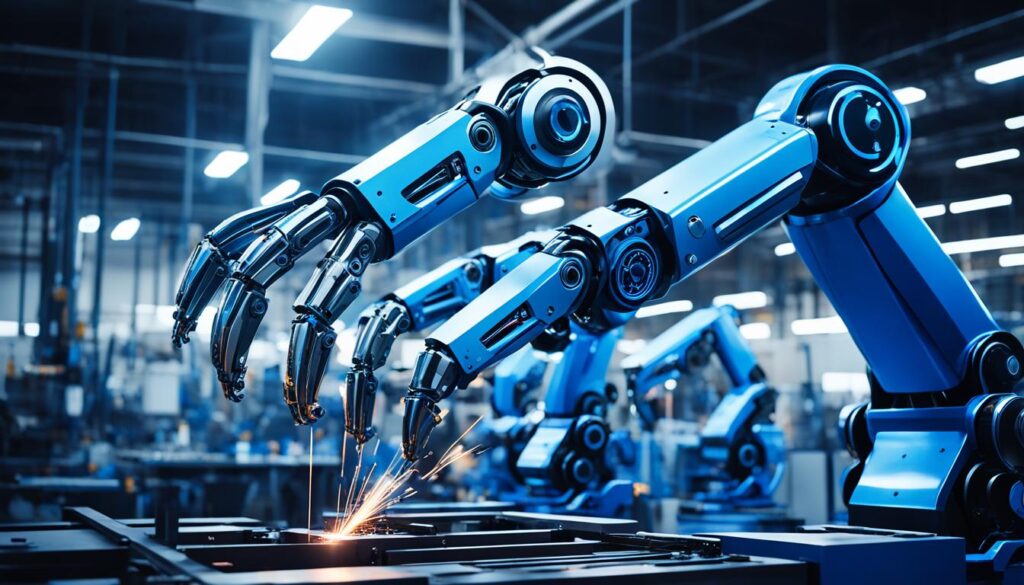“Robotics is not just a science fiction fantasy, but a reality that is transforming the way we live and work.” – Elon Musk
Automation is changing the game in manufacturing, making processes more efficient. Robot arms are a key part of this change. They can do complex tasks like handling materials, putting things together, welding, and painting. Robot arms make things better by being more efficient, safe, precise, and flexible. They are a big deal in industries like cars, electronics, aerospace, and healthcare.
Key Takeaways
- Robotic arms offer enhanced flexibility, strength, and versatility for various industrial applications.
- Collaborative robot arms enable safe human-robot interaction, improving task versatility and efficiency.
- Specialized robot types, such as SCARA, Cartesian, and Spherical robots, excel in specific industries and tasks.
- Robotic arms automate a wide range of manufacturing processes, improving productivity, safety, and precision.
- Advancements in robotics focus on programmability, AI integration, and the development of collaborative robots (cobots).
Unveiling the Marvels of Robotic Arms
Robotic manipulator arms have changed the way we make things today. These machines, also called industrial robot arms, are used in many places, from factories to space. They help with tasks like moving materials, putting things together, checking quality, and working with others, making things better, safer, and more precise.
From Factory Floors to Outer Space
Robotic arms are used in many areas, like aerospace, healthcare, and building, showing what automation can do. Companies like Fanuc, ABB, and Yaskawa lead in making arms for tasks like welding and painting. Meanwhile, iRobot and Intuitive Surgical are creating robots for cleaning and surgery.
Decoding the Mechanics
A robotic arm has a base and joints that move. Links and actuators help the arm move. Each joint lets the arm move in different ways. The end-effector is like the arm’s hand, used for gripping or welding. These arms are designed to move like humans and are known for their efficiency and reliability.
| Key Robotic Arm Metrics | Industry Benchmarks |
|---|---|
| Robotic Arm Adoption Rate | 10% average annual growth over the past 5 years |
| Cost Reduction | 25% average cost reduction in manufacturing processes |
| Error Reduction | 40% reduction in errors in assembly lines |
| Labor Savings | 15% average labor cost reduction due to increased automation |
| Throughput Increase | 30% increase in production throughput |
| Market Growth Forecast | Global robotic arms market to reach $14 billion by 2025 |

The Winter Soldier’s prosthetic arm, made of titanium and then vibranium, has amazed people everywhere. It shows how powerful and versatile robotic arms can be, in both real life and stories.
“The Winter Soldier’s Titanium Arm was damaged and eventually destroyed in a battle with Iron Man in 2016, but the Vibranium Arm he received from T’Challa during the Infinity War proved even more resilient.”
Embracing the Power of robotic arms
At Rhino Tool House, we see how robotic arms are changing the future of making things. These machines have made making things faster, more precise, and flexible in many industries. They help with tasks like moving materials, putting parts together, and even painting or cutting things.
Adding robotic arms to a business brings big benefits like making things faster, better, and more sustainably. These robots can predict and fix problems before they happen, making things run smoother. Thanks to new tech like AI and sensors, they’re getting smarter and more independent.
We know what our clients need at Rhino Tool House. If you’re making products or doing scientific work, our robotic systems can help. We offer top-notch tech and custom solutions to help businesses use robotic arms well. This leads to better work and more new ideas.
 Gmrxe Entertainment and Information
Gmrxe Entertainment and Information




